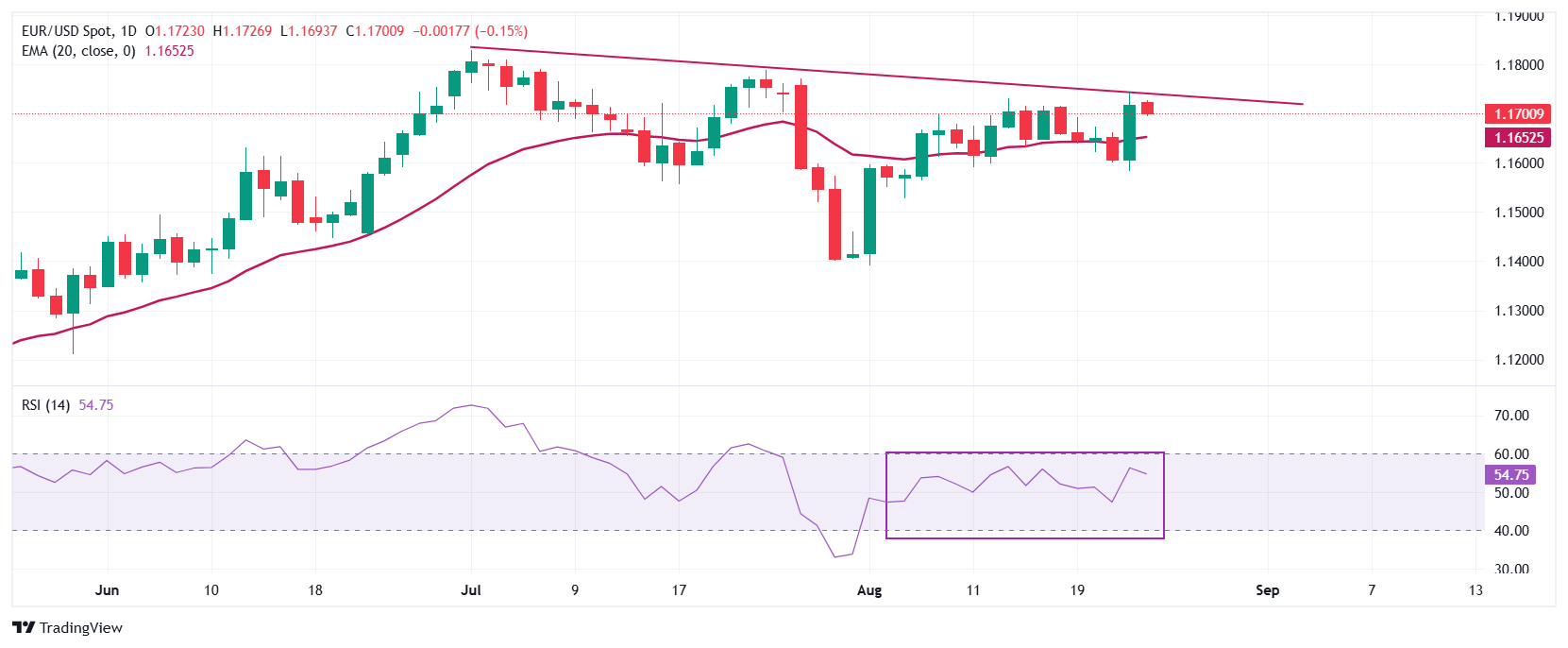EUR/USD Price Forecast: On the verge of trendline breakout above 1.1700
EUR/USD clings to gains above 1.1700 at the start of the week.
Fed’s Powell turns dovish on the interest rate outlook.
This week, investors await inflation data from the US and major economies of the Eurozone.
The EUR/USD pair holds onto Friday’s gains slightly above 1.1700 during the early European trading session on Monday. The major currency pair demonstrates strength as the US Dollar (USD) has come under pressure, following comments from Federal Reserve (Fed) Chair Jerome Powell that the United States (US) central bank has opened the door for interest rate cuts amid growing labor market concerns.
At the time of writing, the US Dollar Index (DXY), which tracks the Greenback’s value against six major currencies, strives to hold its almost four-week low around 97.60.
On Friday, Fed Chair Powell stated at the Jackson Hole Symposium that the central bank needs to adjust interest rate as balance of risks has shifted. Nonetheless, with policy in restrictive territory, the baseline outlook and the shifting balance of risks may warrant adjusting our policy stance," Powell said.
This week, investors will pay close attention to the preliminary inflation data from major economies of the Eurozone for August and the US Personal Consumption Expenditure Price Index (PCE) data for July.
EUR/USD trades close to the downward-sloping trendline plotted around 1.1740 from the July’s high at 1.1830. The near-term trend of the pair is bullish as it holds above the 20-day Exponential Moving Average (EMA), which trades near 1.1652.
The 14-day Relative Strength Index (RSI) oscillates inside the 40.00-60.00 range, suggesting a sideways trend.
A fresh upside move in the pair would become inevitable to near the July’s high at 1.1830 and the round-level resistance of 1.1900 if it breaks above Friday’s high of 1.1740.
On the flip side, a downside move by the pair below Friday’s low of 1.1583 will expose it to the August 5 low of 1.1528, followed by the August 1 low of 1.1392.
EUR/USD daily chart

US Dollar FAQs
The US Dollar (USD) is the official currency of the United States of America, and the ‘de facto’ currency of a significant number of other countries where it is found in circulation alongside local notes. It is the most heavily traded currency in the world, accounting for over 88% of all global foreign exchange turnover, or an average of $6.6 trillion in transactions per day, according to data from 2022. Following the second world war, the USD took over from the British Pound as the world’s reserve currency. For most of its history, the US Dollar was backed by Gold, until the Bretton Woods Agreement in 1971 when the Gold Standard went away.
The most important single factor impacting on the value of the US Dollar is monetary policy, which is shaped by the Federal Reserve (Fed). The Fed has two mandates: to achieve price stability (control inflation) and foster full employment. Its primary tool to achieve these two goals is by adjusting interest rates. When prices are rising too quickly and inflation is above the Fed’s 2% target, the Fed will raise rates, which helps the USD value. When inflation falls below 2% or the Unemployment Rate is too high, the Fed may lower interest rates, which weighs on the Greenback.
In extreme situations, the Federal Reserve can also print more Dollars and enact quantitative easing (QE). QE is the process by which the Fed substantially increases the flow of credit in a stuck financial system. It is a non-standard policy measure used when credit has dried up because banks will not lend to each other (out of the fear of counterparty default). It is a last resort when simply lowering interest rates is unlikely to achieve the necessary result. It was the Fed’s weapon of choice to combat the credit crunch that occurred during the Great Financial Crisis in 2008. It involves the Fed printing more Dollars and using them to buy US government bonds predominantly from financial institutions. QE usually leads to a weaker US Dollar.
Quantitative tightening (QT) is the reverse process whereby the Federal Reserve stops buying bonds from financial institutions and does not reinvest the principal from the bonds it holds maturing in new purchases. It is usually positive for the US Dollar.
